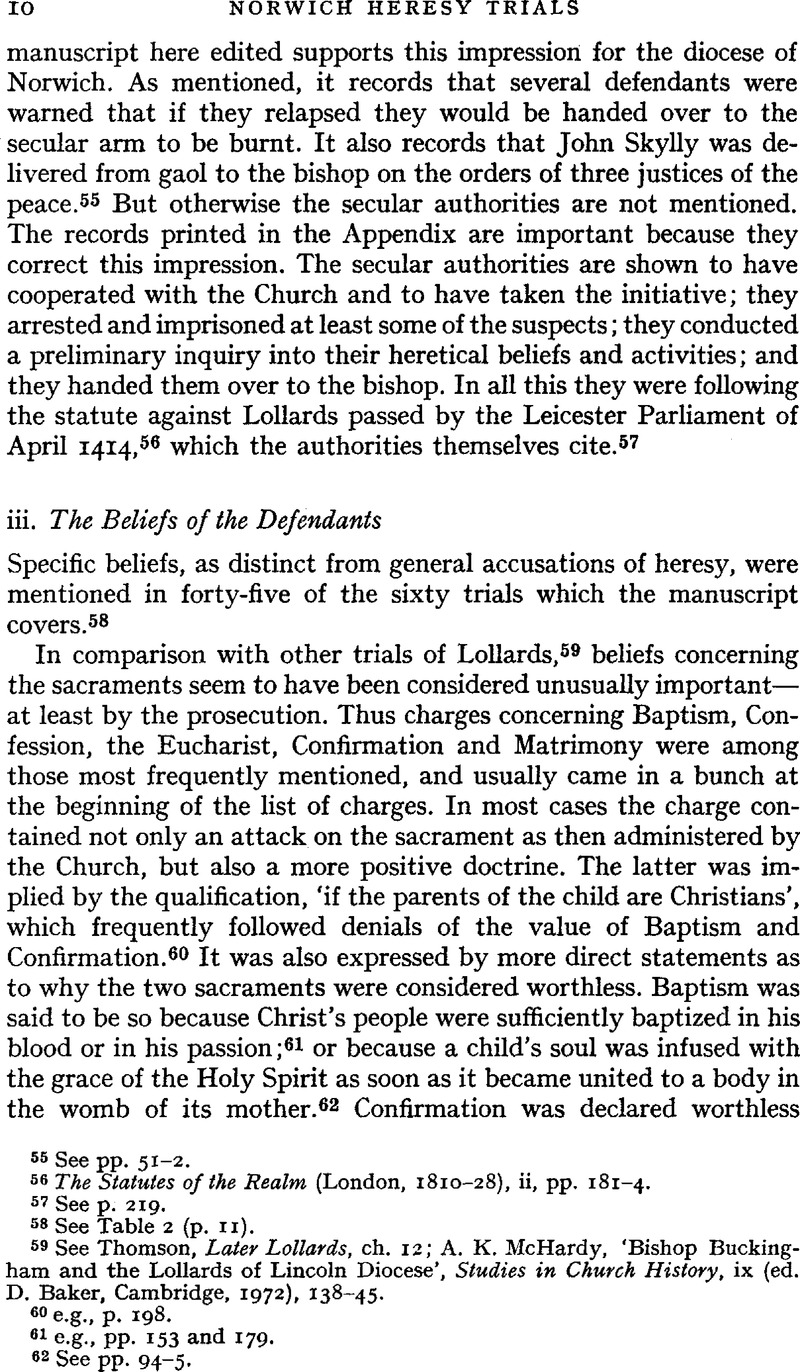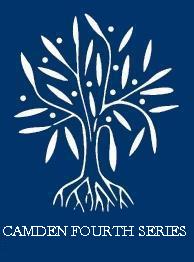No CrossRef data available.
Article contents
iii. The Beliefs of the Defendants
Published online by Cambridge University Press: 21 December 2009
Abstract

- Type
- Introduction
- Information
- Camden Fourth Series , Volume 20: Heresy Trials in the Diocese of Norwich, 1428–31 , July 1977 , pp. 10 - 22
- Copyright
- Copyright © Royal Historical Society 1977
References
56 The Statutes of the Realm (London, 1810–1828), ii, pp. 181–4.Google Scholar
57 See p. 219.
58 See Table 2 (p. 11).
59 See Thomson, , Later Lollards, ch. 12Google Scholar; McHardy, A. K., ‘Bishop Buckingham and the Lollards of Lincoln Diocese’, Studies in Church History, ix (ed. Baker, D., Cambridge, 1972), 138–45.Google Scholar
60 e.g., p. 198.
61 e.g., pp. 153 and 179.
62 See pp. 94–5.
page 11 note 1 The numerals indicate the number of trials in which a particular topic was mentioned. The footnotes refer to possible sources in Wyclifie's works of the views which the defendants allegedly held on the topics, though frequently their alleged views were more extreme than anything that Wycliffe is known to have said or written. Exhaustive references would take up far too much space, and Wycliffe changed his mind on many matters. Therefore the Trialogus, which best represents Wycliffe's mature thought on a wide range of questions, has been taken as the basic work of reference. Only where no references can be found in it are other works referred to. References to these other works are from the Wyclif Society editions (1883–1921); for the edition of the Trialogus used, see above, p.vi.
page 11 note 2 Trialogus, iv. 11Google Scholar (p. 282).
page 11 note 3 Ibid., iv. 23 (pp. 326–8).
page 11 note 4 Ibid., iv. 4 (pp. 255–8).
page 11 note 5 Ibid., iv. 14 (p. 294).
page 11 note 6 Ibid., iv. 22 (p. 323).
page 11 note 7 Ibid., iv. 11 (pp. 280–1).
page 11 note 8 Ibid., iv. 26 (pp. 335–6).
page 11 note 9 Ibid., iii. 30 (pp. 234–5).
page 11 note 10 Ibid., iv. 38 (p. 380).
page 11 note 11 De Ecclesia, xix (pp. 465–6)Google Scholar; Sermones (ii, pp. 164–5).Google Scholar
page 11 note 12 Opus Evangelicum, i. 49–51Google Scholar (i, pp. 177–89).
page 11 note 13 De Civili Dominio, ii. 16 and 18 (ii, pp. 209–33 and 264–5).
page 11 note 14 Ibid., ii. 16 (ii, p. 228).
page 11 note 15 Ibid., ii. 17–18 (ii, pp. 233–75).
page 11 note 16 Ibid., ii. 18 (ii, pp. 264–5).
page 11 note 17 Trialogus, Supplementum, iii (pp. 417–23)
page 11 note 18 De Civili Dominio, i. 17Google Scholar (i, pp. 118–24).
page 11 note 19 Ibid., i. 38 and 43 (i, pp. 279–85 and 374–5); Dialogus, 27Google Scholar (pp. 56–7).
page 11 note 20 Trialogus, iv. 19 and 38 (pp. 311–14 and 382).Google Scholar
page 11 note 21 Ibid., iv. 32 and Supplementum, ix (pp. 357–60 and 448–52).
page 11 note 22 Ibid., iv. 22 (pp. 324–5).
page 11 note 23 Ibid., iv. 32 (pp. 357–60).
page 12 note 63 e.g., pp. 140 and 153.
page 12 note 64 See p. 173.
page 12 note 65 e.g., p. 95.
page 12 note 66 See pp. 103 and 173.
page 12 note 67 e.g., p. 141.
page 12 note 68 e.g., p. 141.
page 12 note 69 e.g., pp. 86 and 111.
page 12 note 70 See p. 91.
page 12 note 71 e.g., pp. 57 and 142.
page 12 note 72 e.g., p. 111.
page 12 note 73 See pp. 103 and 174.
page 12 note 74 But for the alternative of panis sanctificatus mentioned in the records printed in the Appendix, see p. 218. For alternatives to transubstantiation mentioned in other trials, see p. 33, n. 14, and Thomson, , Later Lollards, pp. 246–7.Google Scholar
page 12 note 75 e.g., p. 108.
page 12 note 76 See p. 154.
page 12 note 77 See p. 142.
page 13 note 78 See pp. 69, 72 and 81.
page 13 note 79 Jones, W. R., ‘Lollards and Images: The Defense of Religious Art in Later Medieval England’, Journal of the History of Ideas, xxxiv (1973), 31.Google Scholar
page 13 note 80 e.g., p. 207.
page 13 note 81 e.g., pp. 154 and 158.
page 13 note 82 See p. 142.
page 13 note 83 e.g., pp. 148 and 160.
page 13 note 84 See p. 49.
page 13 note 85 e.g., pp. 154 and 166.
page 13 note 86 e.g., pp. 44 and 179.
page 13 note 87 See p. 91.
page 13 note 88 See p. 86.
page 13 note 89 See p. 218. For the destruction of an image of St Mary at Exeter in 1421, see Foreville, R., ‘Manifestations de Lollardisme à Exeter en 1421?’, Le Moyen Age, lxix (1963), 705.Google Scholar
page 13 note 90 See pp. 53 and 95.
page 14 note 91 Thomson, , Later Lollards, pp. 245–6Google Scholar; and see Sumption, J., Pilgrimage (London, 1975), pp. 71, 196, 258–9, 270, 272–4 and 300.Google Scholar
page 14 note 92 e.g., pp. 71 and 81.
page 14 note 93 e.g., p. 122.
page 14 note 94 See p. 205.
page 14 note 95 See p. 142.
page 14 note 96 See pp. 47, 74 and 148.
page 14 note 97 See pp. 45, 53 and 96. For the attitude of Lollards to St Thomas, see Davis, J. F., ‘Lollards, formers and St Thomas of Canterbury’, University of Birmingham Historical Journal, ix (1963), 1–15.Google Scholar
page 14 note 98 See p. 45.
page 14 note 99 See p. 148. For other attacks on the four men, see Thomson, , Later Lollards, pp. 66 and 122.Google Scholar
page 14 note 100 Trialogus, Supplementum, ii (p. 413).
page 14 note 101 Wycliffe, J., De Ecclesia, ix and xiv (ed. Loserth, J., Wyclif Society, London, 1885–1886, pp. 199 and 310).Google Scholar
page 14 note 102 See p. 47.
page 15 note 103 e.g., p. 153.
page 15 note 104 See p. 42.
page 15 note 105 See p. 74.
page 15 note 106 See pp. 53 and 58.
page 15 note 107 See p. 96.
page 15 note 108 See p. 87.
page 15 note 109 See p. 71.
page 15 note 110 e.g., p. 158.
page 15 note 111 e.g., pp. 71 and 142.
page 15 note 112 e.g., pp. 49–51, 75–6 and 165.
page 15 note 113 e.g., p. 57.
page 15 note 114 See p. 46.
page 15 note 115 See p. 46.
page 16 note 116 e.g., pp. 86 and 177.
page 16 note 117 e.g., pp. 74 and 165.
page 16 note 118 e.g., pp. 61 and 127.
page 16 note 119 See pp. 69 and 154.
page 16 note 120 See p. 153.
page 16 note 121 Mortuary fees were only mentioned once (see p. 86).
page 16 note 122 e.g., pp. 116 and 199.
page 16 note 123 e.g., pp. 141 and 183.
page 16 note 124 See pp. 100–1.
page 16 note 125 e.g., pp. 77 and 153.
page 16 note 126 See p. 74.
page 16 note 127 e.g., p. 61.
page 16 note 128 See p. 103.
page 16 note 129 Hudson, , ‘Examination of Lollards’, 151.Google Scholar
page 16 note 130 e.g., p. 135.
page 16 note 131 e.g., p. 158.
page 17 note 132 Thomson, , Later Lollards, pp. 244–50.Google Scholar
page 17 note 133 e.g., pp. 61 and 166.
page 17 note 134 See p. 73.
page 17 note 135 i.e., living in a religious Order.
page 17 note 136 Hudson, , ‘Examination of Lollards’, 146 and 151.Google Scholar
page 17 note 137 But see: Margery Baxter's alleged advice to a friar (p. 48); and Batild Burell's alleged remark about friars destroying the world (p. 75).
page 17 note 138 McFarlane, , Wycliffe, pp. 59–62 and 92–3.Google Scholar
page 17 note 139 See pp. 141 and 147.
page 17 note 140 Concilia Magnae Britanniae et Hiberniae, ed Wilkins, D. (London, 1733–1737), iii, p. 356.Google Scholar
page 17 note 141 chs. 12–14.
page 17 note 142 e.g., p. 61.
page 17 note 143 e.g., p. 53.
page 17 note 144 e.g., pp. 135 and 147.
page 17 note 145 e.g., pp. 141 and 147.
page 18 note 146 See pp. 45–7.
page 18 note 147 Discussed below, pp. 20–30.
page 18 note 148 See p. 61.
page 18 note 149 See pp. 73 and 77.
page 18 note 150 See p. 154.
page 18 note 151 See p. 42.
page 18 note 152 See p. 49.
page 18 note 153 See pp. 90–1.
page 18 note 154 Thomson, , Later Lollards, p. 130.Google Scholar
page 18 note 155 See pp. 74, 78 and 148.
page 18 note 156 See p. 42.
page 18 note 157 See p. 91.
page 18 note 158 See p. 46.
page 18 note 159 e.g., pp. 86 and 154.
page 19 note 160 e.g., pp. 44 and 67.
page 19 note 161 See pp. 108 and 112.
page 19 note 162 e.g., pp. 49, 61 and 81.
page 19 note 163 Hudson, , ‘Examination of Lollards’, 146–7 and 150–1.Google Scholar
page 20 note 164 Contrast this with, for example, the trial of Thomas Northern before the bishop of Bath and Wells in 1454, in which the accused had to give ‘yes’ or ‘no’ answers to very slanted questions (The Register of Thomas Bekynton, bishop of Bath and Wells, 1443–1465, ed. H. C. Maxwell Lyte and M. C. B. Dawes (Somerset Record Society, xlix–1, 1934–1935), number 898).Google Scholar
page 20 note 165 See pp. 43–51, 72–6, 89–92 and 98–102.
page 20 note 166 Knowles, D. and Obolensky, D., The Middle Ages (The Christian Centuries, ii, London, 1972), p. 451Google Scholar; Chadwick, O., The Reformation (The Pelican History of the Church, iii, Harmondsworth, 1973), pp. 14–15.Google Scholar
page 20 note 167 McFarlane, , Wycliffe, p. 185.Google Scholar
page 20 note 168 Thomson, , ‘John Foxe’, 253–4.Google Scholar
page 21 note 169 Thomson, , Later Lollards, p. 240Google Scholar; Hudson, , ‘A Lollard Compilation’, 66.Google Scholar
page 21 note 170 See footnotes to Table 2 (p. 11).
page 21 note 171 Thomson, , Later Lollards, pp. 244–50.Google Scholar
page 21 note 172 For what Lollardy implied in the social order, especially in the minds of its opponents, see Aston, M. E., ‘Lollardy and Sedition, 1381–1431’, Past &. Present, xvii (1960), 1–44.CrossRefGoogle Scholar
page 21 note 173 See p. 47.
page 21 note 174 Thomson, , Later Lollards, p. 249.Google Scholar
page 22 note 175 Ibid., p. 125.


